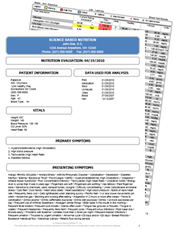Have you noticed the labels of the white bread and the cereals on supermarket shelves that read “good source of fiber”? Now read the nutrition label – three grams. That’s the minimum amount that manufacturers need to pack into a product to have the words “good source of fiber” placed on the label. (1) Some foods (like overly processed white breads) do not contain fiber naturally. So where is this fiber coming from?
Many consumers are buying foods that are fortified with synthetic fiber additives. Food manufacturers, faced with demands to reduce calories, fat, and sodium while increasing fiber and flavor, are increasingly turning to products like inulin.
Manufacturers have discovered they can chemically manipulate the chemical structure of inulin (a natural source of fiber found in asparagus, chicory root, onion, and garlic) to mimic the tastes and textures consumers want in food. (2) These additives are then used to promote “high fiber” in processed foods. But over consumption of these highly processed additives are actually causing more gastrointestinal problems and sensitivities, causing an array of side effects.
While the food industry is using processed inulin and the “three gram” fiber guidelines as a way to increase their sales of grain-based products (1), it’s important for you to understand where to find natural fiber sources. So, how much fiber do you need? The American Heart Association Eating Plan suggests eating a variety of food fiber sources with total dietary fiber intake around 25 to 30 grams a day from food. (3)
Dietary fibers are found naturally in the plants we eat as well as whole grains.
- Soluble fiber:
- slows down digestion by delaying the emptying of your stomach
- sources include: oat cereal, lentils, apples, beans, and nuts
- Insoluble fibers:
- considered gut-healthy fiber and remain intact as they pass through the gastrointestinal tract
- mainly found in whole grains and vegetables
The majority of research promoting dietary fibers comes from studies that utilized fiber rich fruits and vegetables. However, controlled intervention trials have shown no proven protective effects of the dietary supplement of wheat-bran fiber as is used and promoted by the food industry. (4)
In fact, many studies demonstrate that excess intake of fiber may actually be harmful, particularly for gut health. Excess insoluble fiber can bind to minerals such as zinc, magnesium, calcium, and iron, preventing the absorption of these
vital nutrients. (1) And large amounts of soluble fiber like pectin and guar can lead to inadequate protein digestion and reduced pancreatic activity. Thus “the addition of insoluble and soluble fibers to processed foods may actually cause these foods to be even less nutritious than if they were not enriched with any fiber at all!” (1)
It is important to note that natural sources of inulin (asparagus, chicory root, onion, garlic, etc) do have beneficial effects on the body as it promotes healthy guy flora. However, the altered version found in processed foods is not gut friendly. Byproducts created during the fermentation process of these foods can cause symptoms of gas, bloating, diarrhea and nausea. The process is very similar by which cornstarch is converted to high fructose corn syrup. Though processing methods can differ among manufacturers, most commercial products use genetically modified enzymes and an intense chemical process. (5)
Supporting the good bacteria in your digestive system is important because 80 percent of your immune system is located there. (6) The gastrointestinal tract is the body’s first line of defense in terms of immunity. Supporting healthy gut flora with prebiotics and probiotics can help prevent and/or treat symptoms such as diarrhea, yeast infections, irritable bowel, and digestion.
Highly processed inulin is not the only culprit of the additive family that can cause stomach pains. With more foods available now that are processed to ensure a longer lasting shelf life, we as consumers, need to be aware of what these additives are and how excess consumption can affect us.
Reading the labels is one step you can take on educating yourself about ingredients added to processed foods. See our “Understanding Ingredient Labels” newsletter from December 2010 for more information about reading labels.
Chemically processed foods can wreak havoc on your digestive tract. Get started in the right direction toward making steps to correct and improve digestive health by getting a comprehensive blood test and tissue mineral analysis.
By determining deficiencies and toxicities based on your blood chemistry, supplemental guidelines and dietary improvements can correct the balance of your gut flora and help improve your digestive health for the proper breakdown of nutrients. Call us today to get started!
References:
- Kresser, Chris. Myths and Truths about Fiber. February 17, 2012 http://chriskresser.com/myths-and-truths-about-fiber. Accessed on September 29, 2013
- Myers Lowe, Rachael. Food Additive can cause stomach ache . Journal of the American Dietetic Association. June 2010
- Univeristy of California Medical Center . Increasing Fiber Intake. http://www.ucsfhealth.org/education/increasing_fiber_intake/
- Alberts DS, Martínez ME, Roe DJ et.al. Lack of effect of a high-fiber cereal supplement on the recurrence of colorectal adenomas. New England Journal of Medicine. April 20, 2000
- US Patent 5846333—Method of producing fructose syrup from agave plants,” Patent Storm
- Wall Street Journal Gives BIG Thumbs Up to Good Bacteria Jan 31 2009 mercola

